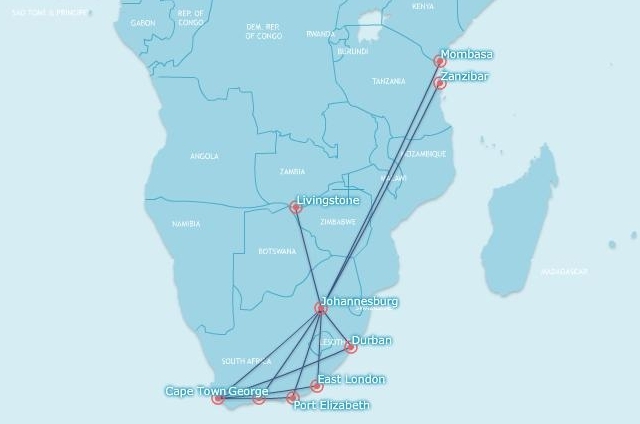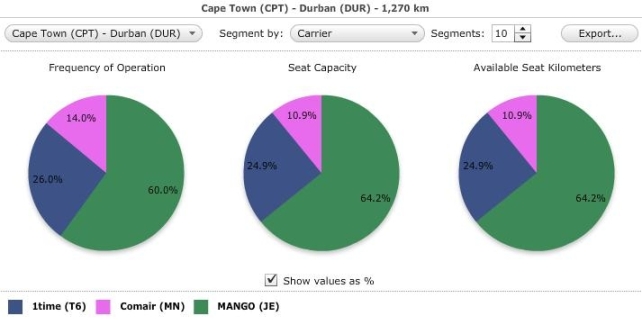The launch of flights later this month from high-profile pan-African start-up FastJet is the latest attempt to kick-start the spread of the low-cost carrier model in the continent.
While budget operators in the south and north of Africa have been on the scene for more than a decade now, the low-cost carrier model remains relatively peripheral in the continent - comprising around 10% of intra-African capacity by ASK. This is perhaps underlined by the collapse of South African budget operation 1time earlier this month, which was one of a handful of low-cost carrier brands in the African market.
"Up until now African aviation has been orientated around business traffic, tourism and higher net-worth travellers. As a result connectivity is incredibly low compared to the rest of the world," said FastJet chief executive Ed Winter during a panel debate at the recent World Travel Market in London on African aviation.
"But over the past few years the wealth has flown in through growing GDPs and is spreading through the population. So there is a much bigger group of passengers that can fly now. The low-cost carrier model enables us to bring fares that will enable this group to travel. I think the time is right. Three to five years ago was probably too early," says Winter.
FastJet marks the most concerted attempt yet to bring a pan-African low-cost carrier to the continent's notoriously fragmented aviation market. Efforts until now have been largely focused on single markets.
The carrier, which begins flying from Dar es Salaam to Kilimanjaro and Mwanza on 29 November, is hoping to short-cut some of the pain of setting up airlines in four different countries by using the existing infrastructure of Lonrho's Fly540 operation. The latter has been operating a mixed turboprop and jet fleet from its bases in Tanzania, Kenya, Ghana and Angola.
The high-profile start-up brings with it plenty of European low-cost carrier know-how - not least in the form of Stelios Haji-Ioannou, whose EasyGroup conglomerate is a key backer, and several of EasyJet's former executives including Winter. "We are using the European model of driving cost out of the business," says Winter, though he recognises the need to address the specifics of the African market, such as limited distribution.
"Things change very quickly. It's very easy to think that we always used credit cards and the internet in Europe," he says, noting the relatively low early levels of online bookings among European carriers. "I don't see why Africa won't change, but you just have to be pragmatic."
Speaking on the same panel, Tewolde Gebremariam - chief executive of Ethiopian Airlines, a carrier which has not been tempted down the low-cost carrier route - points to the market challenges. "The African air transport market is different from Europe and North America. It is not a homogenous market in terms of regulations. The market is much more fragmented," he says.
Crucially, the painfully slow liberalisation of air transport in the continent means that Africa lacks the single aviation market which allowed European and US budget carriers to prosper. This, for example, has necessitated FastJet using different air operators certificates across each country, though Winter stresses that customers will see only one airline.
Winter also suggests that the fragmented nature of the market provides an opportunity. He points to effort to link 16 countries in west Africa through a free trade areas. "Accra [in Ghana] is only connected to four of the other countries. So there is a lack of connectivity. It is fragmented, but it is a group of countries that are trying to work together," he says.
While Ghana and Angola are in the plan, FastJet will initially follow the launch of Tanzanian flights with operations from neighbouring east African country Kenya. The latter's strong home carrier has itself been studying its own low-cost operation, though a year after first announcing Jambo Jet, the project remains in development.
"The things is you have got to do things right. We are not apologetic about that. We want to look at all the options," says chief operations officer Mbuvi Ngunze.
The carrier has received an aircraft licence based on Boeing 737-300s, though Ngunze says no final decision has been taken on the fleet. "We are still doing our homework. You need to make sure you don't just create a mini-KQ [Kenya Airways]. We will not react just because FastJet is coming in," he says.
Jambo Jet's creation illustrates how fast the market is evolving, as one of the first things Kenya Airways chief executive Titus Naikuni did on taking the reins of the airline a decade ago was to drop its first dalliance in the low-cost market. Flamingo Airlines was a short-lived operation using Saab 340s - seldom seen before or since as an aircraft of choice among low-cost carriers - which lasted around three years.
While North Africa has seen low-cost penetration from expanding European budget giants as well as local carriers like Air Arabia, in sub-Saharan Africa it is really only South Africa that has seen low-cost travel gain a foothold . Established carriers Comair and later South African Airways both launched budget brands - Kulula and Mango in 2001 and 2006 respectively. These have since grown to carry 4.4 million people between them in 2011.
Both could grow further now another of the region's budget pioneers, 1time, has been forced to pull the plug on services. 1time Holdings filed for liquidation on 2 November after its court-appointed business-rescue practitioner determined that the company had no reasonable prospect of survival. Its plans to launch a Zimbabwean low-cost subsidiary, Fresh Air, are also now shrouded in uncertainty.
1time's demise is set to have an immediate impact on the marketplace. Mango had already planned to place orders for two new 737-800s over the next 12 months, and it will now increase that figure to pick up 1time's market share, Bezuidenhout says. Comair has yet to announce expansion plans for Kulula, but its shares jumped 10% the Monday after 1time was liquidated.
1time route map (Oct 2012) |
|---|
 |
Source: Innovata Flightmaps Analytics |
Bezuidenhout adds that FastJet's upcoming launch north of the border places a "competitive necessity" on Mango - which is a solely domestic operator - to expedite its regional expansion plans throughout east Africa. The SAA subsidiary has already secured rights to Mauritius and is negotiating access to Zanzibar, Tanzania. While he believes FastJet's vision of a 40-strong fleet by 2016 are optimistic, he is still planning defensively.
Former 1time routes may be among the favoured springboards for Mango's regional growth, which places Zanzibar, Mombasa and Livingstone firmly in its sights. For the mean time, though, domestic services remain the key battleground in South Africa's fledgling low-cost market.
SAA set the scene for a low-cost showdown in 2010, when it withdrew from the country's third busiest domestic route - Durban-Cape Town - in favour of a codeshare with Mango. The subsidiary commanded 64% of low-cost capacity on the sector prior to 1time's collapse.
 |
|---|
FastJet also appears to be considering its options after 1time's grounding, with South African trade union Solidarity claiming earlier this month that the start-up had been negotiating a possible buyout of 1time prior to its liquidation.
Though the carrier declined to confirm whether talks had taken place, it issued a statement announcing that proceeds from a new share offer - targeted to raise $2.4 million - will be used to explore the possibility of opening a base in southern Africa.
"These additional funds will be deployed in assessing an earlier than expected opportunity open to FastJet to interact with the southern African marketplace, and progressing with the opening of further operational hubs for the FastJet network across Africa‚" says the carrier's executive chairperson, David Lenigas.
(Additional reporting by Martin Rivers)
Source: Air Transport Intelligence news























